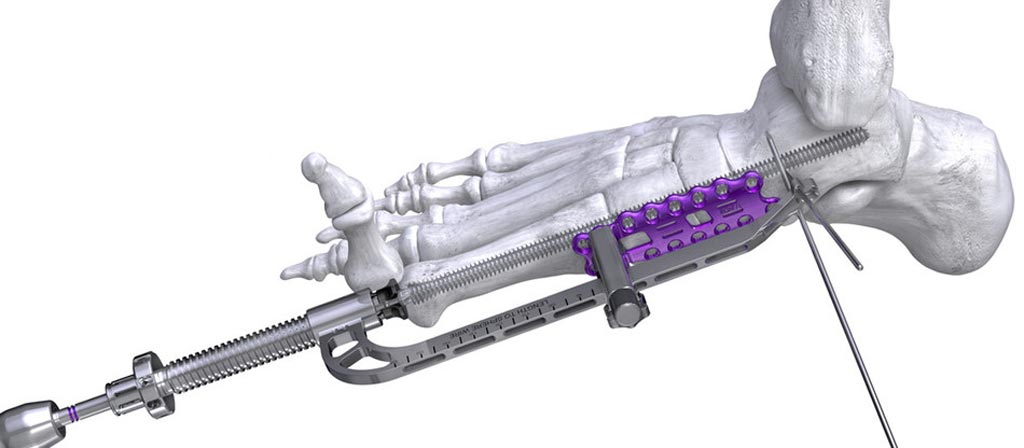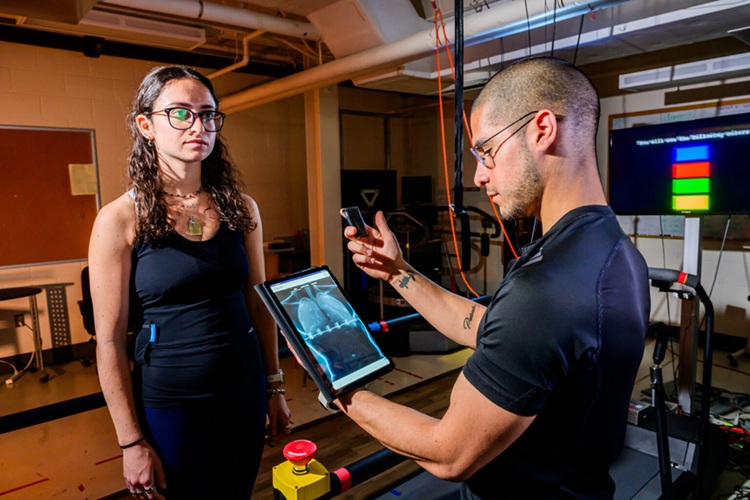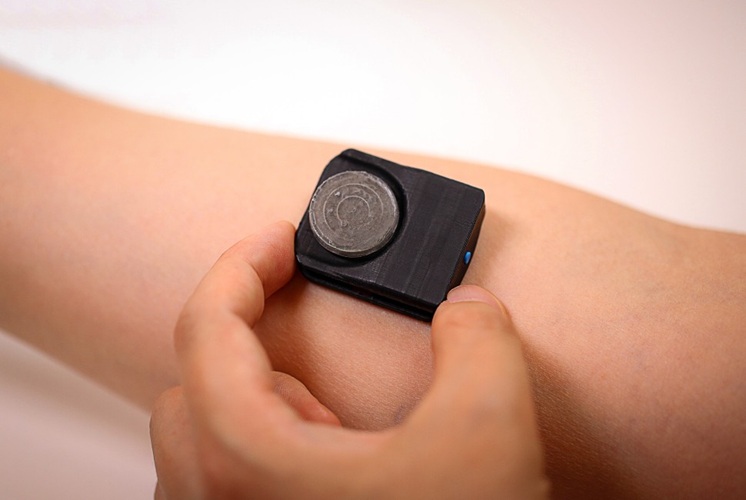Reduction Guide Preserves Medial Column Function
|
By HospiMedica International staff writers Posted on 17 Oct 2019 |

Image: The Joust Beaming Screw System and PRECISION Reduction Guide (Photo courtesy of Paragon 28).
An innovative reduction guide allows surgeons to place a beam precisely while maintaining adequate reduction along the medial column.
The Paragon 28 (Englewood, CO, USA) Joust Beaming Screw System includes 5 mm, 5.5 mm, and 7.2 mm, solid and cannulated beams, all fully or partially threaded. The beams are made of type II anodized titanium (Ti-64AI-4V) for improved fatigue strength. All beams have a sharp tip for ease of insertion and are offered headless to minimize prominence. The 5 mm and 5.5 mm beams are offered in 50-120 mm for varying patient anatomies and to allow for increased bone capture. The 7.2 mm beams are available in 65-185 mm in length to allow surgeons to extend a medial column beam into the posterior aspect of the talus.
The system offers partially threaded and fully threaded options to allow for compression or increased thread purchase, depending on the surgical requirements and patient anatomy. The Joust Beaming Screw System also includes the PRECISION Reduction Guide, which helps position the K–wire from the head of the first metatarsal to the talus, thus allowing a 2 mm thick Gorilla straddle plate to set the trajectory for a beam to pass through, without the hitting any on-axis plate screws and allowing reduced interoperative fluoroscopy time.
Bone plating is a method of fracture fixation in which one or more metal plates are applied across the fracture and anchored, usually by screws, into the fragments; the broken bones must first be surgically reset into their proper position. The method does have some drawbacks; after initially placing the plate on the break or fracture the bones are compressed together and held under some slight pressure, which helps to speed up the healing process of the bone. Unfortunately, the tension provided by the steel plate is lost after several days and the break or fracture is no longer under compression, slowing the healing process.
Related Links:
Paragon 28
The Paragon 28 (Englewood, CO, USA) Joust Beaming Screw System includes 5 mm, 5.5 mm, and 7.2 mm, solid and cannulated beams, all fully or partially threaded. The beams are made of type II anodized titanium (Ti-64AI-4V) for improved fatigue strength. All beams have a sharp tip for ease of insertion and are offered headless to minimize prominence. The 5 mm and 5.5 mm beams are offered in 50-120 mm for varying patient anatomies and to allow for increased bone capture. The 7.2 mm beams are available in 65-185 mm in length to allow surgeons to extend a medial column beam into the posterior aspect of the talus.
The system offers partially threaded and fully threaded options to allow for compression or increased thread purchase, depending on the surgical requirements and patient anatomy. The Joust Beaming Screw System also includes the PRECISION Reduction Guide, which helps position the K–wire from the head of the first metatarsal to the talus, thus allowing a 2 mm thick Gorilla straddle plate to set the trajectory for a beam to pass through, without the hitting any on-axis plate screws and allowing reduced interoperative fluoroscopy time.
Bone plating is a method of fracture fixation in which one or more metal plates are applied across the fracture and anchored, usually by screws, into the fragments; the broken bones must first be surgically reset into their proper position. The method does have some drawbacks; after initially placing the plate on the break or fracture the bones are compressed together and held under some slight pressure, which helps to speed up the healing process of the bone. Unfortunately, the tension provided by the steel plate is lost after several days and the break or fracture is no longer under compression, slowing the healing process.
Related Links:
Paragon 28
Latest Surgical Techniques News
- Intravascular Imaging for Guiding Stent Implantation Ensures Safer Stenting Procedures
- World's First AI Surgical Guidance Platform Allows Surgeons to Measure Success in Real-Time
- AI-Generated Synthetic Scarred Hearts Aid Atrial Fibrillation Treatment
- New Class of Bioadhesives to Connect Human Tissues to Long-Term Medical Implants
- New Transcatheter Valve Found Safe and Effective for Treating Aortic Regurgitation
- Minimally Invasive Valve Repair Reduces Hospitalizations in Severe Tricuspid Regurgitation Patients
- Tiny Robotic Tools Powered by Magnetic Fields to Enable Minimally Invasive Brain Surgery
- Magnetic Tweezers Make Robotic Surgery Safer and More Precise
- AI-Powered Surgical Planning Tool Improves Pre-Op Planning
- Novel Sensing System Restores Missing Sense of Touch in Minimally Invasive Surgery
- Headset-Based AR Navigation System Improves EVD Placement
- Higher Electrode Density Improves Epilepsy Surgery by Pinpointing Where Seizures Begin
- Open-Source Tool Optimizes Placement of Visual Brain Implants
- Easy-To-Apply Gel Could Prevent Formation of Post-Surgical Abdominal Adhesions
- Groundbreaking Leadless Pacemaker to Prevent Invasive Surgeries for Children
- Spectroscopy Technique Improves Surgery for Pediatric Epilepsy Patients
Channels
Critical Care
view channel
Novel Intrabronchial Method Delivers Cell Therapies in Critically Ill Patients on External Lung Support
Until now, administering cell therapies to patients on extracorporeal membrane oxygenation (ECMO)—a life-support system typically used for severe lung failure—has been nearly impossible.... Read more
Generative AI Technology Detects Heart Disease Earlier Than Conventional Methods
Detecting heart dysfunction early using cost-effective and widely accessible tools like electrocardiograms (ECGs) and efficiently directing the right patients for more expensive imaging tests remains a... Read more
Wearable Technology Predicts Cardiovascular Risk by Continuously Monitoring Heart Rate Recovery
The heart's response to physical activity is a vital early indicator of changes in health, particularly in cardiovascular function and mortality. Extensive research has demonstrated a connection between... Read more
Wearable Health Monitoring Device Measures Gases Emitted from and Absorbed by Skin
The skin plays a vital role in protecting our body from external elements. A key component of this protective function is the skin barrier, which consists of tightly woven proteins and fats that help retain... Read morePatient Care
view channel
Portable Biosensor Platform to Reduce Hospital-Acquired Infections
Approximately 4 million patients in the European Union acquire healthcare-associated infections (HAIs) or nosocomial infections each year, with around 37,000 deaths directly resulting from these infections,... Read moreFirst-Of-Its-Kind Portable Germicidal Light Technology Disinfects High-Touch Clinical Surfaces in Seconds
Reducing healthcare-acquired infections (HAIs) remains a pressing issue within global healthcare systems. In the United States alone, 1.7 million patients contract HAIs annually, leading to approximately... Read more
Surgical Capacity Optimization Solution Helps Hospitals Boost OR Utilization
An innovative solution has the capability to transform surgical capacity utilization by targeting the root cause of surgical block time inefficiencies. Fujitsu Limited’s (Tokyo, Japan) Surgical Capacity... Read more
Game-Changing Innovation in Surgical Instrument Sterilization Significantly Improves OR Throughput
A groundbreaking innovation enables hospitals to significantly improve instrument processing time and throughput in operating rooms (ORs) and sterile processing departments. Turbett Surgical, Inc.... Read moreHealth IT
view channel
Printable Molecule-Selective Nanoparticles Enable Mass Production of Wearable Biosensors
The future of medicine is likely to focus on the personalization of healthcare—understanding exactly what an individual requires and delivering the appropriate combination of nutrients, metabolites, and... Read more
Smartwatches Could Detect Congestive Heart Failure
Diagnosing congestive heart failure (CHF) typically requires expensive and time-consuming imaging techniques like echocardiography, also known as cardiac ultrasound. Previously, detecting CHF by analyzing... Read moreBusiness
view channel
Expanded Collaboration to Transform OR Technology Through AI and Automation
The expansion of an existing collaboration between three leading companies aims to develop artificial intelligence (AI)-driven solutions for smart operating rooms with sophisticated monitoring and automation.... Read more















